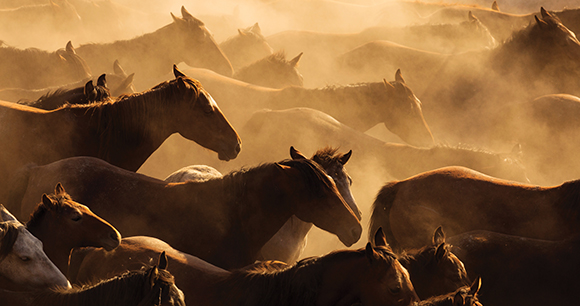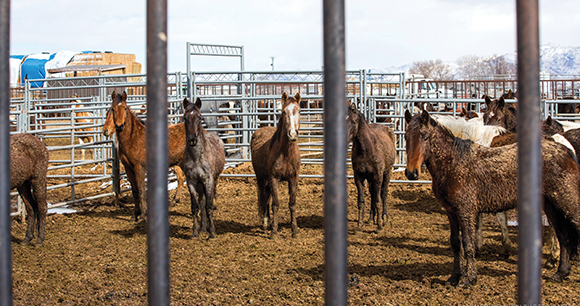Against a backdrop of picturesque mountains, past coils of razor wire, once-wild horses stand in the frozen dirt of the Cañon City Off-Range Corral. The corral—an enormous grid of pipe-paneled paddocks and hay fields that can hold up to 3,000 wild equines—is located within an expansive Colorado Department of Corrections campus. Six (human) prisons lie within a roughly one-mile radius of where the horses stand. Security is strict, and visits to the corral by the public are uncommon and tightly controlled.

For more than 30 years, the corral has operated as a Bureau of Land Management short-term holding facility for wild horses rounded up from the open range. Like other BLM short-term holding facilities, it receives and “prepares” wild equines for sale or adoption. Horses may remain in Cañon City for up to three years. Those not sold or adopted during that time are moved to long-term holding pastures.
The official policy of the BLM, which manages the vast majority of our nation’s wild horses and burros, is to complete processing steps such as Coggins testing (for equine infectious anemia, a potentially fatal disease), freeze marking, and—as of February 2023—vaccinations within the first month. However, consistent lapses in staffing and the aggressive schedule of roundups can result in horses left in limbo for months, with little oversight. In reference to the Cañon City facility, in particular, a May 2022 Comprehensive Animal Welfare Program Team Assessment Report from the BLM concluded that “they simply do not have enough employees on a consistent daily basis to complete all the work required in a timely manner.”
This report came in the wake of a massive mortality event at the facility. The previous year, during a summer studded with controversial roundups, 445 horses were removed from Colorado’s West Douglas Herd Area and sent to Cañon City. Staffing woes and the sheer number of new arrivals resulted in a delay of eight months before any of these horses were vaccinated (a delay that was not, however, a violation of BLM policy at the time).
A vaccination protocol finally got underway in April 2022, only to be halted within a few days when nine of the horses were found dead. Over the next few weeks, equine influenza swept through the herd, killing 146 horses, including 24 foals. West Douglas horses were the only ones at the facility reported to die during this outbreak. The BLM has postulated that exposure to wildfire smoke on the range made them particularly vulnerable to severe respiratory infections, but this has not been confirmed.
As evidenced by this incident, the mass removal of wild horses into holding facilities can lead to overcrowding and rapid spread of disease. At roughly the same time the Cañon City outbreak was occurring, the BLM was contending with a deadly outbreak of strangles—a highly contagious bacterial disease—at the agency’s Wheatland facility in Wyoming, which houses up to 3,500 wild horses.
This fiscal year, the BLM plans to round up approximately 20,000 wild horses and burros, most of whom will find themselves in short-term holding facilities. The BLM touts its Adoption Incentive Program as a way to rehome wild horses removed from the range, but a 2021 New York Times investigation into the program revealed its many problems—including the fact that horses acquired through the program were being sent to slaughter outside the United States.
There are better ways to manage wild horses on the range and provide the federal protections they are due under the Wild and Free-Roaming Horses and Burros Act of 1971. AWI has long supported the use of the porcine zona pellucida (PZP) fertility control vaccine as a safe and effective way to manage wild horse populations. A truly concerted effort to administer immunocontraceptive fertility control within herds would allow wild horses to remain in their natural habitat while reducing the strain on already overburdened holding and adoption systems.
Yet, in 2023, the BLM reported that only 720 fertility control treatments were applied. As of this writing, more than double that number of horses are corralled in Cañon City alone. In recent years, the Cañon City corral has maintained an operating budget of around $3 million. By contrast, the BLM has historically devoted less than 1 percent of its total Wild Horse and Burro Program budget to implementing fertility control programs nationally. In fiscal year 2021, that amounted to $0.9 million.
During the past three funding cycles, AWI helped secure language in annual budget legislation directing the BLM to increase expenditures on immunocontraceptive fertility control, and we are pushing for similar language in spending bills currently under consideration. Meanwhile, we continue to fund on-the-ground projects that strengthen the case for fertility control over capture and confinement.
We also strongly advocate an end to brutal helicopter roundups, whereby panicked horses are chased into enclosures, and which often lead to death and serious injury before the horses even reach the holding facilities. Passage of the bipartisan Wild Horse and Burro Protection Act (HR 3656), introduced earlier this Congress, would end such methods. The ceaseless roundups and long-term captivity of so many horses represent a clear failure in the BLM’s duty to protect wild equines. The tragic deaths at Cañon City underscore an overlooked but dangerous consequence of this failed management approach.
Life in Holding
Life in short-term holding is vastly different from life on the range. While hay and water are provided in each pen, the benefits end there. Families are forever separated, and the ability of these confined wild animals to exhibit their natural behaviors is vastly curtailed.

Equines are separated by sex, and paddocks may further isolate young horses. The soft, sometimes muddy footing necessitates hoof trimmings, a novel requirement after a lifetime of hooves being kept even and trim by miles of varied terrain. In inclement weather, the horses’ knowledge of natural shelter is useless, as fences generally force them to remain exposed. Left with little stimulation, bored foals may chew off the ends of mares’ tails, leaving a pen full of horses without natural fly defense. These facilities undeniably offer a more impoverished existence—replacing autonomy and opportunities to explore with austere, cramped confinement.